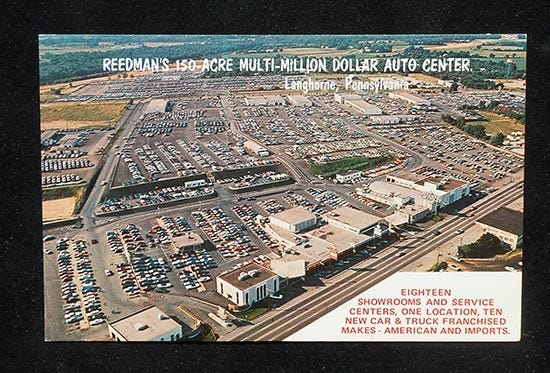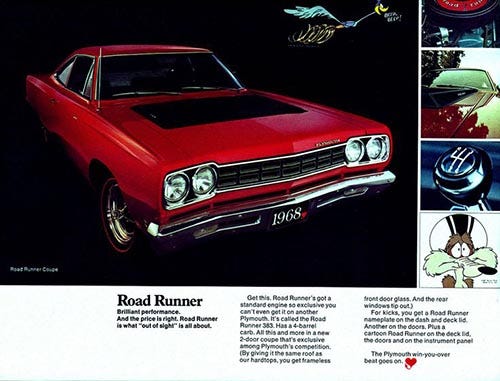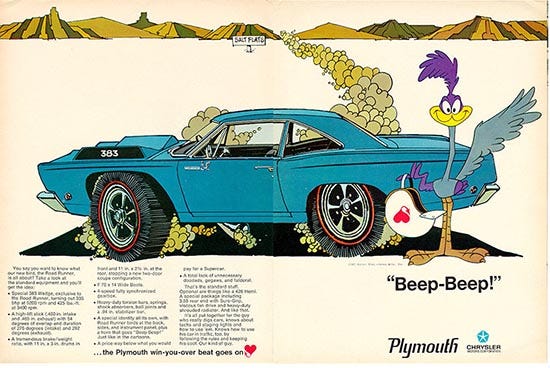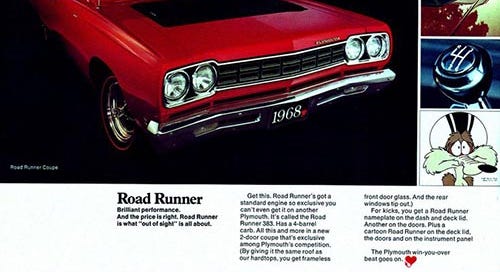Cars We Remember -🏎️💨 Road Runner Success and the Chevy II ‘Sleeper’
The Plymouth Road Runner was a surprise success and the Chevy II came on strong while no one was looking.
Collector Car Corner
By Greg Zyla
Plymouth Road Runner: Surprise, Surprise, Surprise!

Q: Greg, I found one of your articles showing a newspaper advertisement for used cars. It was fun looking at all the great muscle cars and the low prices back then. I’ve always been a big Plymouth Road Runner fan, so can you give me more on the Road Runner? Also, which year is your favorite Road Runner? John L., Lancaster, PA.
A: John, that used car ad you mention belonged to the Reedman Corporation in Langhorne, Pa. I’d spend hours inspecting the ads and looked forward to seeing them every weekend in the Philadelphia papers. As for the Plymouth Road Runner, I liked all the first generation built from 1968 through 1970.

Here’s some history on the “Beep Beep” craze, starting in 1968.
Fully aware Chrysler offered just a few real muscle compared to what GM and Ford/Mercury were rolling out, (although the 1965 to 1967 Hemi Plymouths and Dodges were the main boulevard terrors along with the 1967 Plymouth GTX and Dodge R/T) the executives wanted a low cost intermediate that would hopefully catch the attention of the muscle car buyer.
Specifically, Chrysler agreed to pay Warner Brothers $50,000 for the naming rights of its famous ultra-fast cartoon bird Road Runner, while predator Coyote also came with the deal. They then took a Plymouth Satellite, dropped in powerful V8 engines, added the “beep-beep horn, some Road Runner decals and, presto, the Road Runner was born.
Better yet, you could park it in your driveway for $2,900 as Plymouth hoped its sub $3K muscle car would help them better combat the GM and Ford muscle car success.
Plymouth took its 383 inch block and added 440 cylinder heads, a hot hydraulic cam and kit from the GTX line and then bolted it all together. The result was Road Runner’s standard V8 engine, notably a 335-horse 383 that produced 425 lb.-ft. of torque. Unlike the higher priced “Gentleman’s Muscle Car” GTX, also built on the Satellite platform, the Road Runner was an all business 2-door pillared coupe low on amenities but high on performance.

The initial Road Runners arrived with rubber floor mats, a bench seat, non-roll down rear windows that flipped open to the side and a buyer’s choice of either Torqueflite 3-speed automatic or 4-speed manual transmission.
Following corporate guidance on price, the 1968 Road Runner 383 always stayed below $3,000, unless a consumer selected the one engine option, IE: the real deal “Elephant” 426 Hemi. For just $714 more, you received a 425-horse 426 Hemi, the all-out king of the street and strip. It pushed the price to $3,614, but oh my what a car you had.
All of the early 1968 Roadrunners were post coupes, with a hardtop and a “Coyote Duster Air Grabber” ram air arriving at mid-year and finally pushing that $2,900 over $3,000. For those who bought a Hemi Road Runner and held on to it, regardless of year, they bring hundreds of thousands of dollars at auctions in pristine condition. The recent 2024 Barrett-Jackson and Mecum Auctions prove this point over and over again.

As for showroom activity, Plymouth hoped to sell 2,500 Road Runners in 1968. However, by year’s end nearly 45,000 Road Runners were sold, making it one of the most successful muscle car introductions of all time. Actual 1968 production numbers were 29,240 post coupes and 15,359 hardtops.
Now 100% thrilled with Road Runner’s popularity, Plymouth executives enhanced choices for 1969, adding a convertible along with optional bucket seats. Under the hood, Chrysler added a triple-two barrel 440 V8 option, known as the “440 Six Barrel” in mid-year 1969.
This option produced 390 conservative horsepower and was nearly as fast as the Hemi in stock trim. The important fact is consumers taking home 82,109 Road Runners in 1969, of which only 2,218 were convertibles.
This Road Runner popularity goes on one more year when a redesigned 1970 Roadrunner arrived at dealer showrooms. Of the 41,484 1970 Roadrunners built, only 824 were convertibles, so if you happen to be sitting on a Road Runner ragtop, good for you. This is the also the year the slipstream, winged, NASCAR-ready Superbird joined the Roadrunner group, available with either 440 V8, 440 Six Pak or 426 Hemi.
You could buy one right off the showroom floor as per NASCAR rules, and just 1,935 were ever sold. They looked great and dominated on the NASCAR Superspeedways, but I’ll be honest I never appreciated their looks on the street scene. (Just my opinion, as I’d quickly change my mind if I could afford to buy one today!)
My favorite Road Runner? I would choose a bright blue B5 color code 1968 Hemi or a 1969 or 1970 440 Six Pack, with either a four speed or an automatic. I guess I’m saying any 1968 to 1970 Road Runner parked in my garage would make my day.
Regrettably, beginning in 1971, the “muscle car” engines started arriving with lower compression pistons, gas prices were rising, and cleaner burning engine rules lowered horsepower.
By 1972, the heyday of the true muscle car era was over, but true muscle car fans agree that the Plymouth Road Runner caught the muscle car industry by surprise. Overall, it’s one of the best stories of a car company spending $50K for the rights of a cartoon bird that paid gigantic dividends.
Thanks for your question, John.
Notable ‘sleepers’ 1966 and 1967 Chevy II 327 L79
Video 1967 Chevrolet Nova SS Street Strip Setup ~ 427 L88 Big Block
Q: Greg, I've always loved the 1966 and 1967 Chevy II's with those L79 code 350 horsepower 327 engines. I've owned a 1966 that I bought new with the L79 350 horse engine, and it was one of my all-time favorite cars. How many 1966 Chevy II’s were built with that 350 horse L79 327? Larry O’Connell, Spokane, WA.
A: Larry, I had a good friend by the name of Velton Koons who had a 66 Chevy II SS, blue metallic, with the L79 engine, a Muncie 4-speed and Chevy’s first "hot hydraulic" camshaft as featured in this engine. The L79 became the option of choice of muscle car buyers who were shopping the lower priced Chevy II line, in addition to many who purchased the larger Chevelle model.
I feel the L79 327 engine was perhaps the most popular choice amongst the high performance set when it came to going fast on limited funds. (similar to this week’s Road Runner question).
These 11 to 1 compression ratio L79 327s could motivate the lightweight Chevys to quick quarter mile times with just a little work. If you added headers, 4.56 gears, maybe a larger Holley carb, better ignition and a good tune, you could easily run 12.50's in the quarter-mile.
Even Car and Driver magazine’s Patrick Bedard, a respected motorsport writer (and former Indy 500 starter-I have his press kit!) rated the 1966-1967 Chevy IIs with the L79 327 “one of the best all-time street racers” in a 1990 opinion column.

Said Bedard, "The combination made for one the sneakiest muscle cars ever built. You might not notice a Chevy II in traffic until he got half a car-length on you. Even in a boss machine, you might have to run 80 or 90 mph to get it back. That's how fast those Chevy II's were."
Thanks for your question, Larry, and as for you drag racers out there, remember these two words... “Larry Lombardo.” Lombardo drove Bill "Grumpy" Jenkins small block “Grumpy’s Toy” Pro Stock entries to numerous wins including a NHRA world championship and proved just how fast a small block Chevy could go in the quarter mile against even the best of professionally prepared Hemi and Ford Cleveland engine competitors.
We’ll end on that note.
Greg Zyla is a syndicated auto columnist who welcomes reader interaction on collector cars, auto nostalgia and motorsports at greg@gregzyla.com or extramile_2000@yahoo.com. Snail mail goes to Roosevelt St., Sayre, Pa. 18840







